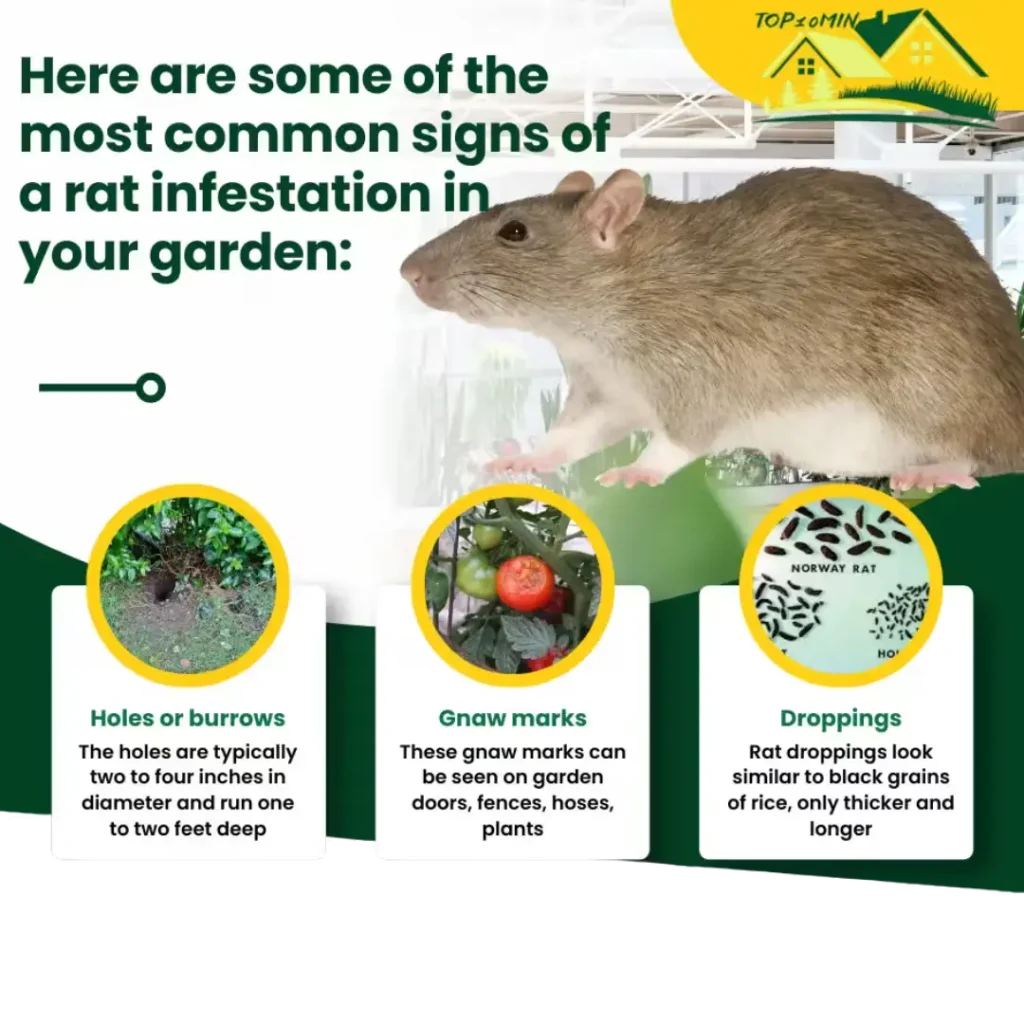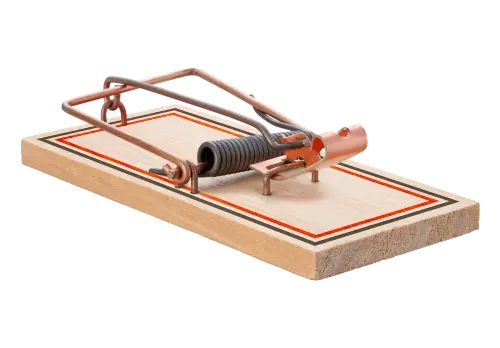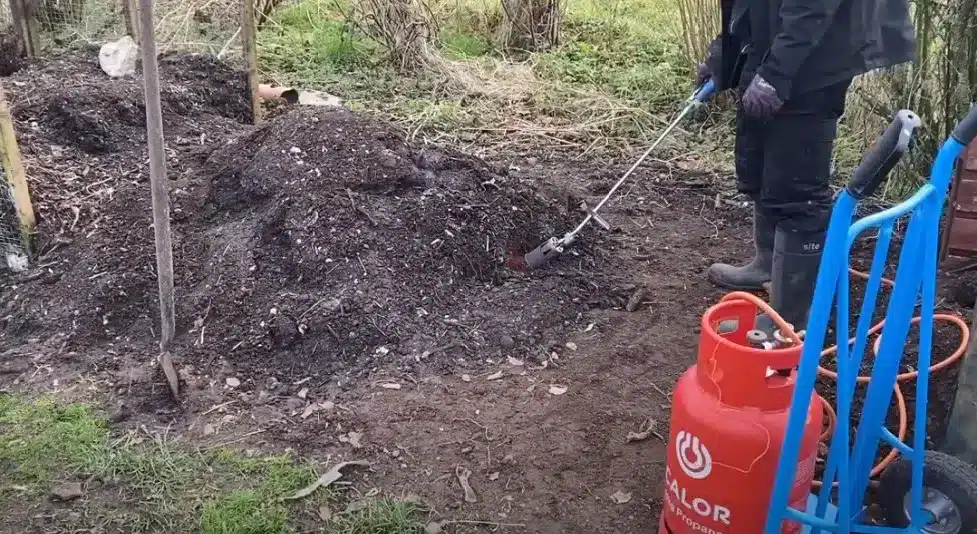Rats 🐀 can be a real nuisance in the garden, damaging your crops and leaving behind droppings that can spread disease. But don’t worry, there are a number of things you can do to get rid of rats in your garden and keep them away for good.
- Why are rats attracted to gardens?
- DIY Rat-Proofing techniques for your garden
- Natural solutions to deter rats effectively
- Trapping rats in my garden responsibly: Best practices
- Long-Term strategies to eradicate rats in my garden
- Preventing rats re-entry to my garden: Essential tips
- Asphyxiation: A Humane and efficient approach to rat control
- Conclusion: Winning the battle against garden rats
Why are rats attracted to gardens?
Rats are opportunistic creatures, always seeking food and shelter. your garden, unfortunately, might be providing them with the perfect environment.
it’s important to know the signs so you can take steps to get rid of them.Here are some of the most common signs of a rat infestation in your garden:

- Holes or burrows: Rats often dig holes or burrows in the ground near food sources, such as gardens. The holes are typically two to four inches in diameter and run one to two feet deep.
- Grease marks: Rats leave behind grease marks along fences, gate posts, steps, or on the exterior of building walls adjacent to a garden or landscape space.
- Flattened vegetation: In grassy areas, the vegetation will be flattened, worn or dead, creating a noticeable path.
- Droppings: Rat droppings are the easiest identifier of rats. Rat droppings look similar to black grains of rice, only thicker and longer.
- Gnaw marks: Rats will gnaw on surfaces to maintain the health and size of their teeth. These gnaw marks can be seen on garden doors, fences, hoses, plants and other materials made out of wood, rubber, vinyl, and low grade concrete.
- Damaged or disappearing plants: If any of your plants become damaged or disappear overnight, then that may be due to rats digging around.
If you see 👀 any of these signs, it’s important to take steps to get rid of the rats as soon as possible. There are a number of different ways to do this, including:
- Trapping: Trapping is one of the most effective ways to get rid of rats. There are a variety of different traps available, so choose one that is appropriate for the size and type of rat you are dealing with.
- Poison ☠️: Poison can also be effective in killing rats, but it’s important to use it carefully and according to the directions on the label.
- Repellents: There are a number of different repellents available that can help to keep rats away from your garden. These repellents typically contain ingredients that rats find unpleasant, such as peppermint oil or cayenne pepper 🌶️ .
DIY Rat-Proofing techniques for your garden
How to DIY Rat-Proof my garden ❓
😄 there are several DIY techniques you can use to get rid of them and prevent them from coming back.
1. Eliminate hiding spots
Rats prefer to live in areas with plenty of cover, such as tall grass, piles of debris, or overgrown shrubs. Keep your garden clean and tidy to eliminate hiding spots for rats.
2. Seal entry points
Rats can enter your garden through even the smallest holes. Seal any cracks or holes in your fence, walls, or foundation with caulk or expanding foam.
3. Remove food sources: Does it work?
Rats are attracted to food, so make sure to eliminate any potential food sources in your garden. This includes:
- 🐶 Pet food.
- 🦜 Bird seed.
- 💩 Compost piles.
- 🍒 Fallen fruit or vegetables 🥕.
4. Secure trash cans
Rats can easily access food from unsecured trash cans. Use trash cans with tight-fitting lids and store them in a secure location.
5. Use traps: An effective but imperfect solution?
Traps can be an effective way to catch and remove rats from your garden. There are several different types of traps available, such as:

- Snap traps.
- Live traps.
- Electronic traps.
6. Use Poison ☠️ : A risky and inhumane option!!!
Poison can be used to kill rats, but it should only be used as a last resort and with caution. Follow the directions on the product label carefully and keep pets and children away from the area where the poison is placed.
By following these DIY techniques, you can effectively rat-proof your garden and enjoy 😊 a pest-free outdoor space.
Natural solutions to deter rats effectively
there are plenty of natural solutions you can use to deter them without harming them or the environment.
- Make your garden less inviting: Rats are attracted to clutter and food sources, so make your garden less appealing to them by:
- Removing piles of debris, wood, or other materials that could provide shelter.
- Keeping your lawn mowed and your garden free of weeds.
- Picking up fallen fruit or vegetables promptly.
- Removing bird feeders or placing them away from your garden.
- Elevate structures, store woodpiles, lumber, and other materials off the ground to eliminate hiding places.
- Use natural repellents: Rats dislike strong scents, so you can use natural repellents to keep them away from your garden. Some effective repellents include:
- Peppermint oil: Rats dislike the smell of peppermint oil. Plant peppermint around your garden perimeter or spray a diluted solution directly on areas where rats are likely to enter.
- Cayenne pepper 🌶️ : The spicy flavor of cayenne pepper repels rats. Sprinkle it around your garden perimeter or mix it with water and spray it on plants.
- Garlic🧄: Another natural rat deterrent is garlic. Plant garlic around your garden or sprinkle crushed garlic in areas where rats are active.
- Bay leaves: The strong aroma of bay leaves also discourages rats. Place bay leaves in areas where rats are likely to nest or enter.
- Catnip 🍃 : Grow catnip plants to deter rats.
- Citrus peels 🍋 : Rats aren’t fond of the scent, so scatter citrus peels around your garden or use citrus based spray.
- mothballs: mothballs aren’t just for wardrobes,strategically place them around your garden, but be cautious, as they can be toxic.
- Encourage natural predators(Solution with limitations): Natural predators, can help to keep rat populations in check. Encourage these predators to visit your garden by providing them with nesting boxes or food.

Cates: Felines are instinctive hunters and can be effective at deterring and controlling rats. However, be mindful of the risks cats pose to birds and other small wildlife 🐈.
Birds of Prey: Owls 🦉 , hawks, and other raptors are natural predators of rats. Encourage these birds by installing nesting boxes or perches in your garden.


Dogs: Certain dog 🐕 breeds have a strong prey drive and can be trained to hunt rats. However, ensure your dog is well-trained and supervised to avoid unwanted interactions with other animals.
- Considerations for using natural predators:
- Safety of other animals: Be mindful of the impact predators may have on desirable wildlife like birds or squirrels.
- Predator effectiveness: The success of relying on natural predators can vary depending on the local ecosystem and the number of rats present.
- Responsible pet ownership: Ensure your pets are vaccinated, well-trained, and supervised to prevent unintended harm to other animals or themselves.
Working with nature by utilizing natural predators and biological controls offers a humane and environmentally friendly solution for getting rid of rats in your garden while maintaining a balanced ecosystem.
Trapping rats in my garden responsibly: Best practices
If trapping is necessary to control rats in your garden, it’s important to do so responsibly to avoid harming the animals or the environment. Here are some best practices to follow:
Use humane traps:
Choose traps that are designed to kill rats humanely, such as live traps or snap traps with a quick-release mechanism. Avoid using glue traps or poisons, as these can cause suffering and death to non-target animals.
Place traps strategically:
Place traps along rat runways or in areas where there is evidence of rat activity, such as near burrows, food sources, or water.
Bait traps properly:
Use bait that is attractive to rats, such as peanut butter, cheese, or bacon. Place the bait in the back of the trap to encourage rats to go all the way in.
Check traps regularly:
Check traps daily to remove any captured rats. If you catch a rat, release it immediately in a safe location far from your home and garden.
Dispose of traps properly:
If you use disposable traps, dispose of them properly in a sealed garbage bag. If you use reusable traps, clean them thoroughly with soap and water before reusing them.
Dispose of deceased rats responsibly:
Wear gloves and double-bag the rat before placing it in an outdoor garbage bin.
Important Note ✍️: Poison baits should be avoided as they pose a risk to other wildlife and pets.
By following these responsible trapping practices, you can effectively control rats in your garden while minimizing harm to the animals and the environment 🏞️.
Long-Term strategies to eradicate rats in my garden
While trapping can be an effective short-term solution, it’s important to implement long-term strategies to eradicate these pests from your garden. Here are some effective methods:
- Eliminate food sources: Rats are attracted to food sources, so it’s crucial to eliminate these as much as possible. Secure garbage cans with tight lids, store pet food in airtight containers, and remove any fallen fruits or vegetables from your garden.
- Eliminate water sources: Leaking pipes, ponds, and birdbaths offer the water rats need to survive.
- Remove hiding places: Rats need shelter from predators and the elements, so removing potential hiding places can discourage them from staying in your garden. Trim overgrown vegetation, remove piles of debris, and seal up any holes or cracks in your home or shed.
- Use natural repellents: Certain plants and scents can repel rats, such as peppermint, eucalyptus, and rosemary. planting these around your garden can help keep rats away.
- Encourage natural predators: Predators such as owls, hawks, and cats can help control rat populations. Provide nesting boxes or perches for these predators to encourage them to stay in your garden.
- Use ultrasonic devices: Ultrasonic devices emit high-pitched sounds that can deter rats. While their effectiveness can vary, some gardeners have found them to be a helpful deterrent.
- Professional pest control: If all else fails, you may need to contact a professional pest control company. They can assess the situation and recommend the most effective methods for eradicating rats from your garden.
- Move Things Around: Frequently rearrange garden objects and obstacles.
- Pet hair: utilize your furry friends scatter pet hair, especially from dogs and cats, around the garden.
Preventing rats re-entry to my garden: Essential tips
Rats can be a persistent problem in homes and gardens, and preventing their re-entry is crucial for maintaining a pest-free environment. By following these essential maintenance tips, you can effectively seal off entry points and discourage rats from returning:
- Keep vegetation trimmed: Overgrown vegetation provides cover for rats, making it easier for them to approach your home or garden. Keep trees, shrubs, and grass trimmed to eliminate hiding places.
- Clean up debris: Piles of debris, such as wood, leaves, or junk, provide shelter for rats. Remove these to reduce their nesting opportunities.
- Maintain drainage: Rats are attracted to moisture, so it’s important to maintain proper drainage around your home and garden. Fix leaky faucets, repair gutters, and redirect downspouts away from your foundation.
- Inspect and repair cracks: Cracks in walls, foundations, or pipes can provide entry points for rats. Regularly inspect these areas and repair any cracks promptly.
- Install barriers: Using fencing and wire mesh to deter rats.
- Use mesh bags to protect crops.
By implementing these maintenance tips, you can effectively prevent rats from re-entering your home or garden.
Asphyxiation: A Humane and efficient approach to rat control

How to get rid of rats in your garden? can be a frustrating and time-consuming task. But with the right approach, you can effectively control the rat population in your garden.
Asphyxiation offers a humane and efficient way to get rid of rats in your garden. This method involves sealing the entrances to a rat’s burrow or nest, except one. A propane-powered flame weeding torch or canisters of argon or CO2 gas are then used to introduce asphyxiating gases into the burrow.
Here are the steps for using asphyxiation to get rid of rats in your garden:
- Locate and seal all of the entrances to the rat’s burrow or nest except one.
- Insert the flame of the torch into the remaining burrow entrance for a few minutes, then quickly seal that entrance as well.
- The rats will be trapped inside the burrow with the smoke, carbon dioxide, and/or argon, and will quickly die from asphyxiation.
Important Note ✍️ : Do not use asphyxiation in areas where there is a fire risk.
With a little effort, you can use asphyxiation to effectively control the rat population in your garden. This method is humane, efficient, and relatively easy to use.
Conclusion: Winning the battle against garden rats
Dealing with a rat 🐀 infestation in your garden can be challenging, but with the right strategies and techniques, you can effectively get rid of rats and prevent future problems.
Getting rid of rats in your garden requires a multi-faceted approach that combines understanding their behavior, implementing humane control methods, and taking preventative measures. by addressing the factors that attract rats, making your garden less inviting, and employing appropriate control techniques, you can successfully manage and prevent infestations. remember, consistency and a long-term perspective are crucial for lasting success.
Whether you choose to utilize natural predators, live traps, or exclusion techniques, prioritize humane methods that minimize suffering. By creating a clean, well-maintained garden environment and remaining vigilant, you can enjoy a thriving garden without unwanted rodent guests.

About the Author
With over a decade of hands-on experience in home garden care, I’ve cultivated a deep-rooted passion for nurturing indoor greenery.



